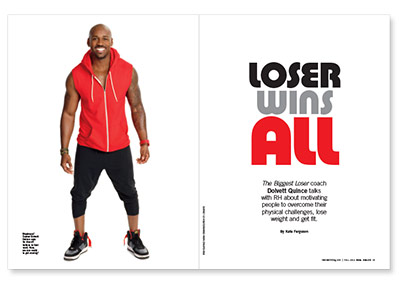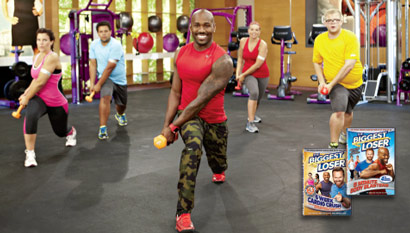
When Dolvett Quince was a child, he and his three siblings were placed in foster care. The memory of that time in his life is bittersweet for Quince because, although a family adopted him and his siblings, he was physically and mentally abused. But the experience forged the strength he employs today as a personal trainer who gets his clients results.
“I got strength from weaknesses, so I applied those life lessons into what I do today,” Quince says. “I think one of the key elements of being a personal trainer is helping someone believe in the impossible. I help people believe that no matter where they are in their life, there’s always hope to be better.”
Quince joined The Biggest Loser in 2011 and soon became a favorite of fans who watch TV’s popular weight-loss contest. Quince’s training approach is to help clients enjoy fitness. “I show my clients ways to have fun working out, so it’s not a chore or something you do because something is wrong, but something you do because it’s a part of your day,” he says. “Also, I teach them how to look at food as a friend, not an escape.”
The methods Quince employs are proven techniques many experts suggest people use. For example, to achieve weight loss simply incorporate healthier foods and exercise into your life.
Today, in the United States, nearly 155 million adults age 20 or older are overweight or obese, according to the American Heart Association. Experts classify this as a crisis of epidemic proportion. “There are things that concern me as a father, such as schools taking physical education out [of the curriculum], as if movement isn’t necessary for children,” Quince says. “But I think physical fitness starts with parents, our schools and education.”
Indeed, physical activity and weight loss are the subjects Quince instructs his clients about on the TV show and in several DVDs for The Biggest Loser workout series. What’s more, he wrote a best-selling book, The 3-1-2-1 Diet, about his weight-loss program.
“I used myself as a guinea pig starting out in terms of the metabolism and the way the body reacts to the program scientifically. I eat clean one day, and then I cheat a little bit, and then I go back to eating clean again for two, and then cheat again,” Quince explains. “I noticed that every time I cheated, my body was a little tired because of all the work that I put in on the clean days, and it was just amazing the response that I got. I applied it to my clients early on in my career, and they had success.”
Among the clients who transformed their bodies with Quince’s eat-and-cheat program are celebrities such as actress Angela Bassett and football player Daniel Wilcox, a tight end for the Baltimore Ravens. Quince says that the program “is the secret” responsible for the success enjoyed by contestants he trains on the show.
But what happens after the diet ends? Quince says that by the time his clients go back to the real world, they’ve achieved a lifestyle change that translates into a new way of eating forever.
“I think my book, more than anything, says this is something that you can do from now until you’re 90 years old,” Quince says. “Unlike many diet books, my program doesn’t tell you to deprive yourself, and it’s not a strict regimen. But it simplifies an entire week and your entire life, so it’s very specific and very direct. You can have what you’re accustomed to, but when you eat and exercise this way you see results.”
Indeed, most health experts agree that, ultimately, deprivation diets don’t work for the long-term. The best weight-loss diets change the unhealthy ways that people eat and live.
 |
| The Biggest Loser DVDs feature Dolvett Quince leading exercise classes based on the popular TV show |
“People can cut back on calories and lose weight on almost any diet,” Willett says. But keeping weight off over the long run is another story. “Thus it is more important to find a way of eating that you can stay with for the rest of your life,” he suggests. “For this reason, any eating plan you choose should be satisfying and allow variety, and should also be nutritionally sound.”
In general, Quince’s 3-1-2-1 diet fits this description. The program emphasizes “eating clean,” defined as meal choices that consist of lean proteins, green vegetables and smart carbs. In addition, Quince stresses portion control to maximize weight loss, and he allows the occasional indulgence to satisfy cravings, boost metabolism and strengthen dieters’ willpower so they stick with the plan.
As for exercise, Quince believes physical activity is key to a fit, healthy lifestyle, and the benefits go far beyond just liking what you see in the mirror. Quince’s motto, “Changing lives one rep at a time,” is essentially a step-by-step technique that he has successfully used to help his clients transform their bodies and outlook on life. “It’s pretty amazing to watch the transformations and listen to the testimonies today from the book,” he says. “But the proof is in the pudding.”
In addition, the benefits of exercise transcend simply keeping the pounds at bay. According to the Centers for Disease Control and Prevention, regular physical activity is one of the most important things we can do for our health. In general, becoming and staying active not only controls our weight but also reduces our risk of cardiovascular disease, type 2 diabetes, metabolic syndrome and some cancers. Basically, it increases our chances of living longer.
What’s more, physical activity also strengthens our bones and muscles, improves our mental health and mood, and betters our ability to perform everyday activities. For example, exercise helps prevent older adults from falling.
Despite this wealth of benefits, however, less than 48 percent of all American children and adults meet the most recent physical activity guidelines. According to these guidelines, children and adolescents, ages 6 to 17, should be able to perform 60 minutes or more of physical activity each day. What’s more, adults, ages 18 to 64, should engage in 2 hours and 30 minutes of moderate-intensity aerobic activity each week along with muscle-strengthening activities that work all their major muscle groups on two or more days each week.
For adults, 65 and older, who are generally fit and aren’t limited by illnesses, the guidelines are the same as for adults in the previous age group. But this group should also engage in one hour and 15 minutes of vigorous-intensity aerobic activity, such as jogging or running, and muscle-strengthening activities on two or more days each week to work their legs, hips, back, abdomen, chest, shoulders and arms.
“As a personal trainer, I motivate people to go beyond what I teach them, and show people they can exercise on their own and there’s a way to make it part of their lifestyle,” Quince says.
Still, as a personal trainer, he’s a big believer in tapping into group support.
Quince suggests a buddy: “Don’t go at it alone, do it as a team player, whether it’s with a co-worker or a family member.”






Comments
Comments